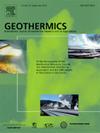Review of simulation methods for co-axial ground heat exchangers: Simplified models, predictions, and comparisons
IF 3.9
2区 工程技术
Q3 ENERGY & FUELS
引用次数: 0
Abstract
The calculation of heat extraction for buried ground heat exchangers (GHEs) is a significant research topic in the geothermal energy utilization field. Due to the considerable size of computational domain of buried pipes, various simplified models and solutions have been developed to achieve efficient simulation. However, the characteristics of existing simplified methods have yet to be comprehensively evaluated and compared. This article presents critical reviews of simplified solution models for co-axial GHEs, comparisons between available experimental measurements and predictions, and comparative analysis of various prediction methods. Unlike detailed numerical methods that solve full set of governing equations including continuity, momentum, energy, and coupled turbulence transport, simplified models use a one-dimensional (axial) approach to simulate fluid flow and heat transfer of the working fluid, assuming azimuthal symmetry. Radial heat transfer is modelled applying Newton's law of cooling, Nusselt number correlations and thermal resistance from Fourier's law of conduction. Either two-dimensional or three-dimensional rock-soil models are applied mostly. This review focuses on elucidating various Nusselt number correlations and the thermal properties of working fluid and rock-soil. Additionally, the relatively small discrepancies in various simulation methods can be primarily attributed to that the validations for the accuracy of these methods predominantly rely on the short-term results of working fluid temperatures. This review aims to clearly outline the advantages and disadvantages of existing simplified model algorithms, providing a reference for the accurate prediction of heat exchange rates in buried pipes.

同轴地热交换器的模拟方法综述:简化模型、预测和比较
地埋式换热器的抽热量计算是地热能利用领域的一个重要研究课题。由于埋地管道的计算域相当大,为了实现高效的仿真,人们开发了各种简化模型和解。然而,现有简化方法的特点尚未得到全面的评价和比较。本文介绍了同轴温室气体简化解模型的关键综述,现有实验测量和预测之间的比较,以及各种预测方法的比较分析。与详细的数值方法解决全套控制方程,包括连续性、动量、能量和耦合湍流输运不同,简化模型使用一维(轴向)方法来模拟流体流动和工作流体的传热,假设方位对称。径向传热采用牛顿冷却定律、努塞尔数关联和傅立叶传导定律的热阻进行建模。主要采用二维或三维岩土模型。本文着重阐述了各种努塞尔数相关关系以及工作流体和岩土的热性质。此外,各种模拟方法的差异相对较小,主要是由于这些方法的准确性验证主要依赖于工作流体温度的短期结果。本文旨在明确现有简化模型算法的优缺点,为准确预测埋地管道热交换率提供参考。
本文章由计算机程序翻译,如有差异,请以英文原文为准。
求助全文
约1分钟内获得全文
求助全文
来源期刊

Geothermics
工程技术-地球科学综合
CiteScore
7.70
自引率
15.40%
发文量
237
审稿时长
4.5 months
期刊介绍:
Geothermics is an international journal devoted to the research and development of geothermal energy. The International Board of Editors of Geothermics, which comprises specialists in the various aspects of geothermal resources, exploration and development, guarantees the balanced, comprehensive view of scientific and technological developments in this promising energy field.
It promulgates the state of the art and science of geothermal energy, its exploration and exploitation through a regular exchange of information from all parts of the world. The journal publishes articles dealing with the theory, exploration techniques and all aspects of the utilization of geothermal resources. Geothermics serves as the scientific house, or exchange medium, through which the growing community of geothermal specialists can provide and receive information.
 求助内容:
求助内容: 应助结果提醒方式:
应助结果提醒方式:


